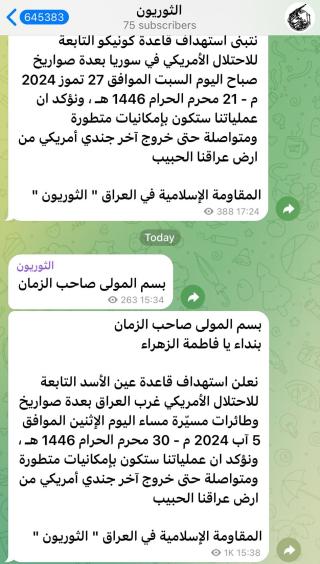The strikes are not yet numerous enough to form a definitive pattern, but they probably reflect deep militia divisions over whether to renew anti-coalition attacks in earnest amid the Gaza war.
On August 5, al-Asad Air Base was struck at least once with a rocket attack that reportedly wounded five U.S. personnel. By the latest Washington Institute count, the incident was the 189th attack on U.S. forces in Iraq, Syria, and Jordan since the Gaza war erupted last October. The new attack followed a July 30 airstrike on a Kataib Hezbollah (KH) base in Jurf al-Sakhar, which itself followed a July 25 militia attack on al-Asad with 122 mm rockets. In between the two al-Asad strikes was a similar tit for tat on July 25-26, involving militia rocket attacks on the Conoco coalition base in Syria and an immediate U.S. defensive strike on a rocket truck.
These attacks echo the pattern seen after Prime Minister Mohammed Shia al-Sudani’s return from the United States in April, when Iran-backed militias launched one attack on al-Asad and one in Syria, reminding Sudani and the world that the self-styled muqawama (resistance) does not approve of the ongoing U.S. presence in Iraq. The heavy U.S. retaliation on July 30—which reportedly targeted a drone being prepared for use and also killed one Houthi specialist visiting from Yemen—seemed to have started the current sequence of militia attacks on August 5, which will probably draw another lethal U.S. response. If American troops are in fact wounded, the muqawama forces involved in the strike either fumbled one of their standard “aim-to-miss” operations or truly intended to risk escalation.
New “Islamic Resistance” Claimant
Thus far, only one online muqawama brand has claimed the four new attacks: the Islamic Resistance in Iraq–al-Thawrayoun (Revolutionaries). This would not be the first time a claim by the umbrella IRI brand has received a subtitle: on November 5 and 12, 2023, two mortar attacks on al-Asad were claimed by “IRI-Dhafireen.”
In the new claims, al-Thawrayoun posted standardized communiques that end with the promise that its attacks will not cease “until the last American soldier leaves the land of our beloved Iraq.” The sub-brand’s Telegram account has a mere seventy-five subscribers, which is very few for a group claiming four anti-U.S. attacks in just twelve days, possibly because no major muqawama propaganda outlets had reposted its claims as of August 5.
What can we make of this burst of anti-U.S. strikes? One thing is clear: elements among the Iraqi muqawama, especially within KH, are frustrated that they are neither doing appreciable damage to Israel nor being permitted to attack U.S. bases since the heavy American retaliation and embarrassment to the Sudani government in January-February. These elements may have underestimated the U.S. sensitivity to new probes of American red lines and now find themselves locked into a tit-for-tat sequence, whether through bad luck or deliberate provocation. Either way, they are now bracing for new U.S. strikes.
The fact that al-Thawrayoun’s claims have not been widely reposted could indicate that the new brand is simply a tribute effort unrelated to any actual kinetic operators. More likely, however, it signals that the muqawama establishment—personified by Sabereen News—does not widely support the militants controlling the new brand and carrying out the current attacks. It also suggests that al-Thawrayoun does not tend toward the Harakat Hezbollah al-Nujaba faction of the muqawama, whose propaganda efforts are generally handled by outlets like the Jihad Brothers Team.
The balance of evidence indicates that the perpetrators of the July-August attacks are KH elements that seek a greater role in the current regional struggle—something that PMF operational commander, senior KH figure, and U.S.-designated terrorist Abdul-Aziz al-Mohammadawi (aka Abu Fadak) has emphasized in recent public addresses. This camp may hope to draw Baghdad into a deeper clash with Washington and thereby trigger the withdrawal of U.S. forces. And if Iran’s wider “axis of resistance” launches retaliatory strikes against Israel in the coming days as expected, this KH faction could seek to maximize Iraqi involvement and get in some bonus hits on U.S. bases in al-Tanf, Syria, and Erbil (both of which are seen as playing a role in Israel’s defense), and perhaps even other bases (e.g., al-Asad; Syrian coalition sites east of the Euphrates River).







































